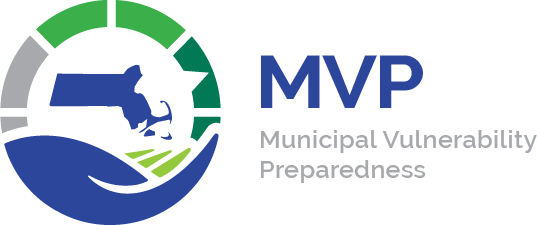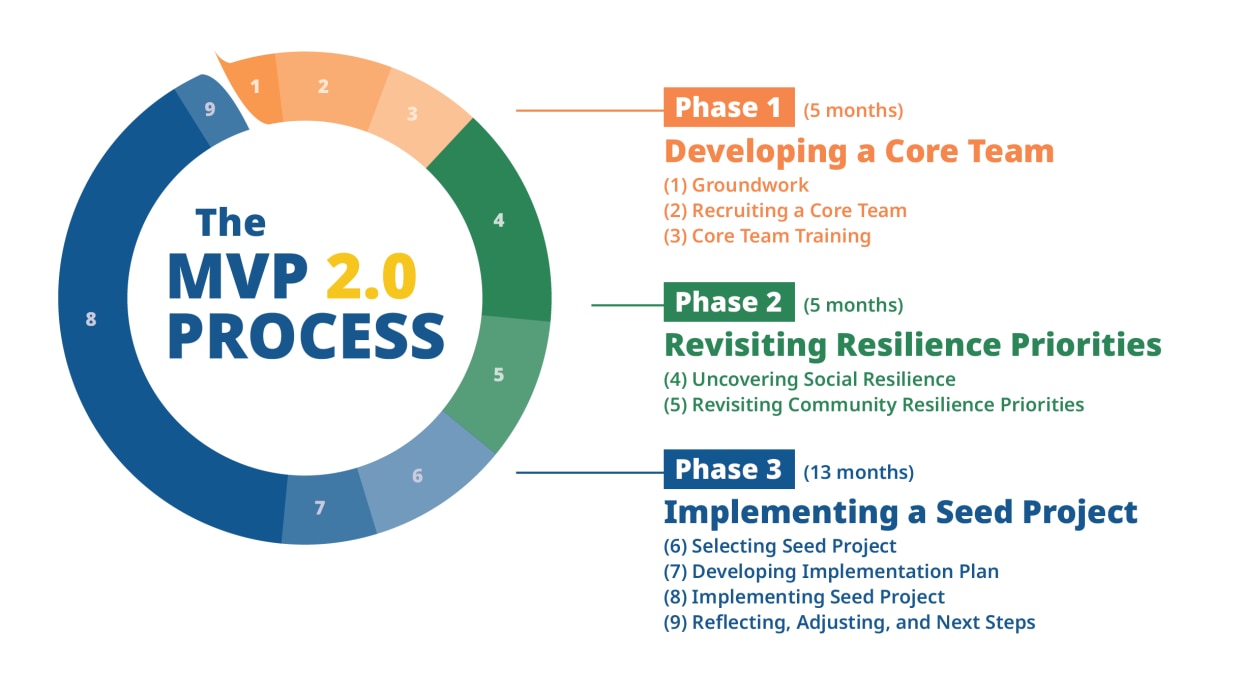MVP Planning 2.0 Overview
MVP 2.0 fills gaps from the original MVP planning process (MVP 1.0), builds on the work communities have done to date, and supports communities with new processes, tools, and resources for building resilience.
Through MVP 2.0, communities can revisit resilience priorities with a focus on equity and translate those priorities into action through project development and implementation. This updated program has a greater focus on building social resilience and explores the factors that create vulnerability or resilience for people living or working in your community. The process will focus on connecting and collaborating with community members, and expanding the voices involved in climate resilience efforts.
MVP 2.0 is designed to be completed over two years, knowing that it takes time to build new relationships, expand the involvement of the broader community, and work together to develop and implement a project.
MVP 2.0 2023-24 Pilot Round
EEA is currently piloting the program with 32 communities and 1 tribe through FY24-25. Participating pilot communities can be found here.
Applications for the FY24-25 MVP 2.0 Pilot round are closed. The next round of applications is expected to open in late 2024. Those eligible to apply include municipalities, federally-recognized and state-acknowledged Tribes, and Regional Planning Agencies applying on behalf of a municipality(ies).
The MVP team hosted a recent webinar about this FY24-25 MVP 2.0 Pilot Grant program. The recording can be accessed here. The slides can be accessed here.
How is MVP 2.0 different from MVP 1.0?
How is MVP 2.0 different from MVP 1.0?
-
MVP 2.0 is not a traditional planning process! You will revisit your resilience priorities, but MVP 2.0 does not involve producing or updating a plan.
-
MVP 2.0 expands community involvement. The process focuses on input from the broader community and specifically people who will be most impacted by climate change.
-
MVP 2.0 dives deeper into social resilience. The process and tools help identify root causes of social vulnerability and what it will take to build community resilience.
-
MVP 2.0 focuses on translating priorities into action. The grant provides guidance, tools, and guaranteed funding to complete a resilience project.
-
MVP 2.0 trains a community team. In doing so, the expertise stays within the community.
MVP 2.0 Planning Process
The MVP 2.0 Planning Process Guide provides complete instructions on how to lead your community through the process. Process steps and support tools are summarized below.
(Step 0) Getting Started/Hiring a Primary Vendor
Before formally beginning the MVP 2.0 process, shortly after being notified of receipt of an MVP 2.0 Grant, awardees will coordinate a meeting with their MVP Regional Coordinator to kick-off the process and proceed with selection and hiring of their primary vendor. Resources for identifying and engaging an MVP 2.0 Vendor include:
- Example Request for Proposals
- Vendor qualifications
- MVP 2.0 Sample Budget
- The Boston Foundation's Racial Equity Capacity Builder's Directory
- MA Supplier Diversity Office's Directory of Certified Businesses
- Primary Vendor Draft Contract Language
(Step 1) Groundwork
In Step 1, a small group of municipal staff, with support from their vendor, will identify the lived expertise and perspectives that will be important to include on your Core Team. This step sets the stage to expand the involvement of the wider community in climate resilience planning, specifically to make sure that the priorities of people who will be most affected by climate change shape decisions. The GEAR Community Guide can help explore who lives in the community. Step 1 results in the completion of the Social Resilience Roadmap.
(Step 2) Recruiting a Core Team
In Step 2, awardees will recruit and confirm members for the Core Team that will lead the MVP 2.0 process. The Core Team will have approximately ten people, including municipal staff and community liaisons (people with strong connections to populations most likely to be impacted by climate hazards). For communities without paid staff, “municipal staff” may include community members who often play a municipal staff-type role. Core Team position descriptions and recruitment talking points as well as a working database of community-based organizations around the state are available to support this step. Step 2 will result in a list of confirmed Core Team members.
(Step 3) Core Team Training
The Core Team will complete a series of MVP 2.0 trainings to equip them with knowledge, skills, and tools for building equitable community resilience. The training consists of two parts: one on climate resilience and another on equity and climate justice. The Climate Resilience Video Modules and accompanying Discussion Guides address climate data and projections, vulnerability, and how to develop an actionable project. This part of the training will be facilitated by the primary vendor. The Equity and Climate Justice Learning Series address the root causes of social inequity, equity-centered community processes, and measuring equity. You will receive instructions on how to sign up for this live, virtual part of the training after receiving an MVP 2.0 grant.
(Step 4) Uncovering Social Resilience
Step 4 is focused on identifying factors that contribute to vulnerability and resilience for people who live and work in the community. The data and information collected in this step will provide key insight for approaching a Seed Project and future Action Grants. Core Teams will develop an Engagement Plan for connecting with a range of community members, using GEAR to investigate data related to community vulnerability and resilience, and document their findings related to social vulnerability and resilience in the Social Resilience Roadmap.
(Step 5) Resetting Resilience Priorities
Step 5 focuses on revisiting and updating community resilience priorities (from MVP 1.0), based on progress to date and new information. This step provides a moment to make sure that community resilience priorities reflect what was heard from EJ and other priority populations in the community or region. The Core Team will complete the Resilience Priorities Guide. The Engagement Plan provides support for developing an approach for vetting updated community resilience priorities with the community.
(Step 6) Selecting a Seed Project
The Core Team will develop a Seed Project idea and will vet the project idea with the community. A Seed Project is a project selected by the Core Team that will jump-start or advance the community’s resilience priorities, and that can be completed in 9-10 months. Communities will receive $50,000 of guaranteed funding to complete a Seed Project with no local match required. Core Teams will be able to draw on inspiration from the Example Seed Projects as well as the GEAR guides, which provide actions to consider and case studies. By the end of this step, the Core Team will have completed the Seed Project Plan (Part A) to select a Seed Project.
(Step 7) Developing an Implementation Plan
Core Teams will build out an implementation plan for the Seed Project, including mapping out the project’s goals, key partners, tasks, deliverables, timeline, budget, and metrics of success. The implementation plan will be captured in the Seed Project Plan (Part B). The MVP 2.0 grant includes funds to support a subject matter advisor(s) who can help advise on the development of the implementation plan. In some instances, your subject advisor may become the vendor that implements the project.
(Step 8) Implementing the Seed Project
Before Step 8, Core Teams will contract with an implementation vendor. The expertise of the implementation vendor will depend on the Seed Project. Step 8 then involves implementing the Seed Project, which should take approximately nine to ten months to complete. For many communities, implementation of a Seed Project will provide the groundwork for future Action Grants.
(Step 9) Reflecting, Adjusting, and Next Steps
In the final step, the Core Team will reflect on the process—including the approach for gathering community input and collaborating on the Seed Project—in order to evolve and improve the process for future resilience building efforts. The Reflection Roadmap is completed to document what was learned and what could be approached differently in the future. To close out the MVP 2.0 process, Core Teams will submit the MVP 2.0 Final Submission Form with completed deliverables, documentation of spent funds, as well as photos and other documentation related to the Seed Project.
Guides for Equitable & Actionable Resilience (“GEAR”)
New with MVP 2.0, Guides for Equitable & Actionable Resilience (GEAR) supports communities as they explore community resilience and vulnerability. Users can pair a climate hazard (e.g., heat) with a community system (e.g., housing) to learn about key issues at the intersection of these factors. GEAR provides a series of questions to further explore the topic in a given community or region, as well as case studies and considerations for taking action.
Additional Resources
- MVP 2.0 Overview Two-Pager
- Frequently Asked Questions (FAQs)
- Resources for Core Team Recruitment
- MVP Program Contacts
- Resources for current MVP 2.0 Pilot Communities:
- Equity and Climate Justice Learning Series Information:
- Registration Links (for current MVP 2.0 grantees only):
- Wave 3 (Mondays @ 6pm via Zoom - April 22nd, April 29th, May 6th): Register Here
- Wave 4 (Tuesdays @ 6pm via Zoom - June 11th, June 18th, June 25th): Register Here
- Pre-Training Homework (Videos & Participant Guides):
- Training 1: Video | Participant Guide
- Training 2: Video 1 | Video 2 | Participant Guide
- Training 3: Video 1 | Video 2 | Participant Guide
- Registration Links (for current MVP 2.0 grantees only):
- Equity and Climate Justice Learning Series Information:

